绩效管理咨询方法论英文版
- 格式:ppt
- 大小:1.65 MB
- 文档页数:40
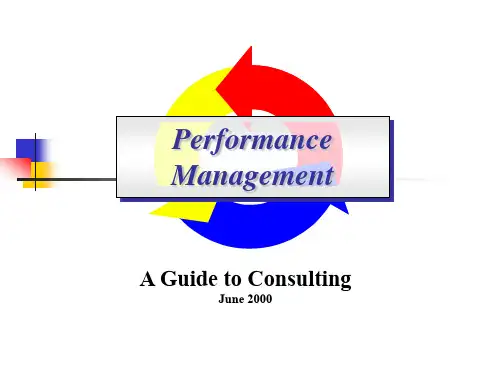
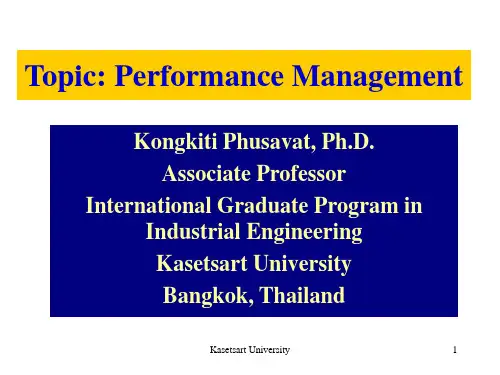


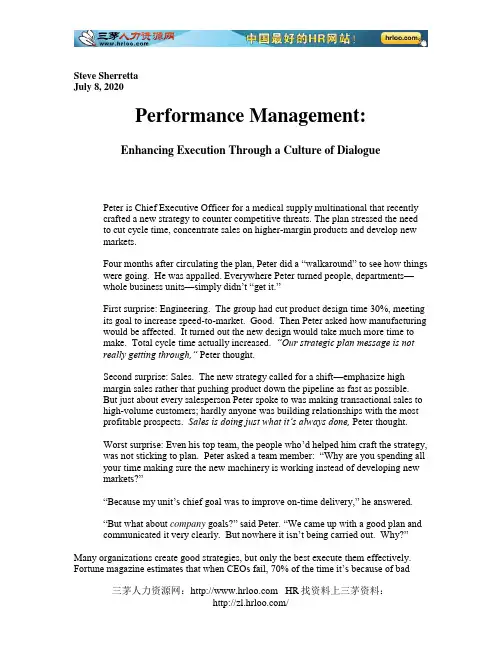
Steve SherrettaApril 5, 2013Performance Management:Enhancing Execution Through a Culture of Dialogue Peter is Chief Executive Officer for a medical supply multinational that recentlycrafted a new strategy to counter competitive threats. The plan stressed the needto cut cycle time, concentrate sales on higher-margin products and develop newmarkets.Four months after circulating the plan, Peter did a “walkaround” to see how things were going. He was appalled. Everywhere Peter turned people, departments—whole business units—simply didn’t “get it.”First surprise: Engineering. The group had cut product design time 30%, meeting its goal to increase speed-to-market. Good. Then Peter asked how manufacturing would be affected. It turned out the new design would take much more time tomake. Total cycle time actually increased. “Our strategic plan message is notreally getting through,” Peter thought.Second surprise: Sales. The new strategy called for a shift—emphasize highmargin sales rather that pushing product down the pipeline as fast as possible.But just about every salesperson Peter spoke to was making transactional sales to high-volume customers; hardly anyone was building relationships with the mostprofitable prospects. Sales is doing just what it’s always done, Peter thought.Worst surprise: Even his top team, the people who’d helped him craft the strategy, was not sticking to plan. Peter asked a team member: “Why are you spending all your time making sure the new machinery is working instead of developing newmarkets?”“Because my unit’s chief goal was to improve on-time delivery,” he answered.“But what about company goals?” said Peter. “We came up with a good plan and communicated it very clearl y. But nowhere it isn’t being carried out. Why?”Many organizations create good strategies, but only the best execute them effectively. Fortune magazine estimates that when CEOs fail, 70% of the time it’s because of badexecution.1 Weak execution is pervasive in the business world, but the reasons for it are largely misunderstood. Why is it that no one in Peter’s organization was acting in sync with the strategy? Unless we understand the reasons, we can’t hope to solve the problem. Imagine someone h itting a tennis ball. When the brain says “hit the ball,” it doesn’t automatically happen. The message travels through nerve pathways down the arm and crosses gaps between the nerve cells. These gaps, or “synapses,” are potential breaks in the connection. If neurotransmitters don’t carry the message across the gap, the message never gets through, or it gets distorted. When that happens, either the arm doesn’t move at all, or it moves the wrong way.Creating a “culture of dialogue”Just like a nervous system, organizations also have gaps that block and distort messages. The secret to effective strategy execution lies in crossing hierarchical and functional gaps with clear, consistent messages that relay the strategy throughout the organization. Sound s imple? It’s not. The reason is that the “neurotransmitters” in organizations are human beings—executive team members, senior managers, middle managers and supervisors—whose job it is to make sure that people’s behavior is aligned with the overall strategy. Doing what it takes to achieve alignment is very difficult. It is what Ram Charan calls, the “heavy lifting” of management, and it’s the key to executing strategy.As we’ll see later, there is an important difference between companies that successf ully align behavior with strategy and those that do not. Companies that effectively execute strategy create a “culture of dialogue.” A culture of dialogue encourages pervasive two-way communications where individuals and groups 1) question, challenge, interpret and ultimately clarify strategic objectives; and 2) engage in regular performance dialogue to monitor behavior and ensure it is aligned with strategy.Three keys to managing performanceA culture of dialogue doesn’t happen instantly, any more tha n a fluid tennis stroke does. It takes practice, persistence and hard work. So how exactly can leaders ensure that strategy messages go all the way down the line—that the tennis ball gets hit correctly? The three keys to managing performance effectively are:1.Achieving radical clarity by decoding strategy at the top. Many organizationsthink they send clear signals but don’t. In some cases, managers subordinate broad strategic goals to operational goals within their silos. That’s what happened with Pe ter’s top team. Elsewhere, top team members often have too many “top”priorities—we’ve seen as many as 100 in one case—which results in mixed signals and blurred focus. Strategy decode requires winnowing priorities down to amanageable number—as little as five.1“Why CEOs Fail,” by Ram Charan and Geoffrey Colvin, Fortune magazine, June 21, 1999.2.Setting up systems and processes to ensure clarity. Once strategy is clear,organizations must create processes to ensure that the right strategy messages cascade down the organization. These include: strategy-centered budget and planningsessions; staff and team meetings to discuss goals; performance managementmeetings; and talent review sessions. Dialogue drives all these processes. Eachrepresents a “transmitter opportunity,” where strategic messages are conveyed and behavior is aligned with goals.3.Aligning and differentiating rewards.Leaders must make sure rewards encouragebehaviors consistent with strategy, which sounds easy but isn’t. Differentiation is about making sure that stars get significantly more than poor performers. But almost everywhere managers distribute rewards more or less evenly. As we’ll see, lack of effective performance dialogue is a key contributor to dysfunctional reward schemes.We list these three items separately but they are, of course, interconnected. Systems and processes depend on clarity from the top. Differentiation and alignment of rewards depend on managers using performance systems effectively. Dialogue is the glue that holds it all together. But not just any dialogue will do. It must be dialogue with purpose, focused on performance.Link to company valuationCompanies that manage performance well—General Electric comes to mind—have higher market valuations. Why? Because, more and more, institutional investors view strategy execution as a vital factor influencing stock prices.Just a few years ago institutional investors relied almost exclusively on financial measures for company valuations. Now 35% of a market valuation is influenced by non-financial, intangible factors, according to a study by Ernst & Young.2 The study showed that “execution of corporate strategy” and “management credibility” ranked number one and number two in importance to institutional investors out of 22 non-financial measures. John Inch, a managing director and analyst at Bear Stearns notes that in some sectors, such as diversified industrial companies, intangibles account for even more—up to half a company’s value. “You can take even a mundane asset and inject good management and have something pretty strong,” says In ch.2 Based on a study conducted by Sarah Mavrinac and Tony Siesfeld for the Ernst & Young Center for Business Innovation.1. Achieve Radical Clarity by decoding strategy at the topThe first step in successfully executing strategy is achieving clarity on the top team, which is frequently the source of garbled signals.Lack of Clarity at the TopA recent Hay Group study 3 shows a disturbing lack of clarity on top teams(organizational clarity measures the extent to which employees understand what is expected of them and how those expectations connect with the organization’s larger goals). The chart below shows dramatically higher levels of clarity on outstanding vs. average teams. In fact the biggest single difference between great and average top teams and typical ones was in the level of internal clarity. See Figure 1.Figure 1: Organizational Climate and Teams[Change Hay/McBer to “Source: Hay Group, Inc.” in final version]And a Lack of Clarity BelowWorkers at lower levels strongly feel this lack of clarity. Figure 2 looks at satisfaction levels for workers planning to leave their organizations within two years versus those planning to stay longer. This study showed that a key reason people leave their jobs is 3 Hay Group partnered with Richard Hackman of Harvard University and Ruth Wageman of Dartmouth College to identify the dynamics of top executive teams and their impact on performance. From an initial group of 48 teams, the researchers narrowed their study to 14 teams, many from large global organizations. Each team member represented the head of an organization, a major business division, or a major geography. 5818that they feel their companies lack direction. Even among employees planning to stay more than two years at their companies, only 57% felt their organizations had a clear sense of direction.Figure 2: Key reasons why employees leave their companiesClarity mattersWhy do employees crave clarity? Think about it. What could be more demoralizing than the realization that your hard work is not contributing to overall company goals? Employees want to do the “right” thing, but they can only do so if they know what the right things are.Unfortunately, as we saw in our opening vignette, companies often don’t communicate strategic goals effectively. An oil refinery client, for example, set a strategic goal to cut costs. To see how well the message had gotten through, an operations team leader held a strategy decode session where he quizzed his team members on what they felt was the chief priority. Ten team members produced four different “top” objectives, including cost-cutting, safety, environmental compliance and reducing sales processing time. The message hadn’t got through. The team leader called his team together and created a “transmitter opportunity.”“Don’t you guys realize that if we can’t cut our refining costs by three cents a gallon, they’re going to shut us down?” he said.“Is that all you need us to do?” replied the team members, taken aback. United by a clear direction and shared ownership of the cause, team members enthusiastically cut costs by five cents per gallon over the following year while continuing to maintain good safety and environmental records.Narrowing priorities4Source: Hay Group, Inc. The results are from our Employee Attitude Survey, which sampled some 300 companies representing more than 1 million workers. Our survey queried management, professionals, salespeople, information technologists, and clerical and hourly workers. The “gap” referred to in the table is the “satisfaction gap” between workers planning to leave within two years and those planning to stay longer.Having too many priorities can lead to lack of clarity. AeroMexico, for example, had worked with a strategy consulting firm that delivered a 249-page report listing key performance indicators (KPIs) for measuring progress by the enterprise. The good news was that the KPIs gave the top team metrics for measuring success. The bad news was that there were 100 of them, and they weren’t prioritized.“It was clear that execu tion would suffer unless we identified the most important ones, says AeroMexico CEO Arturo Barahona. “So we discussed which ones connected most directly with our strategic priorities and where we were in the business cycle, and each team member settled on five chief goals.” By gaining clarity on key objectives, the team greatly increased the odds that signals would transmit clearly down the line.Getting buy-in at the topHay research on teams has shown that it’s not uncommon for team members to nod the ir heads in agreement when new strategies are set in meetings, then go back to their division or department and carry on exactly as they had before. In effect, they end up sabotaging the plan. That’s why gaining buy-in is essential to effective execution, and dialogue is what makes it happen.IBM created an executive team consisting of six Ph.D-level technical leaders at an applied research unit. Their mission: build strong relationships with top research universities so that IBM could recruit innovative scientists capable of developing breakthrough products. The problem was that the Ph.Ds, all world-class scientists, were used to competing for research dollars and dismissing each other's ideas to advance their own. Getting them to work jointly and be held accountable for business results was going to be very difficult.In the first group meeting, the vice president simply assigned accountabilities to the various team members. "I could see the scientists digging in their heels, says Harris Ginsberg, an internal leadership consultant who attended the meeting. "No one was going to dictate to them what they should do." Even if they'd said yes to the VP's directives, adds Ginsberg, they would never have followed through.Ginsberg, who helps IBM business units clarify and execute strategy, knew the key was to get the scientists talking to each other. So he coached the vice president to change her behaviors. Rather than hand out directives, he suggested ways she could stimulate team dialogue about how to meet objectives. Ginsberg also counseled other team members about the need for a "consensus process" on an interdependent team.They all "got" it. At the next meeting the VP said, "Our mandate is to create breakthrough products. Without access to talent at the top universities, we won't succeed. How are we going to get it?" At first, Ginsberg recalls, she met silence. Finally one team member raised her hand. She was willing to "get out there to the universities, and be more visible, go out with the recruiter and the senior human resources people," said Ginsberg. She also agreed to help some up-and-coming scientists learn how to develop relationships with universities.A second team member said he would "help her make some calls." The ice wasbroken and all the team members eventually took on group responsibilities. "Itwas all about dialogue," says Ginsberg. "Until the individual leaders embraced the unifying elements of the strategy for the good of the enterprise, they only attended to their own mission. The dialogue helped them buy-in, agree to some shared activities, and begin to work more collaboratively."2. Set up systems and processes to create clarityWhy is executing strategy so difficult, even when the plan is clear? Because good execution only happens when employee behavior is aligned with strategy. And many managers can’t, won’t or don’t create the “transmitter opportunities” required to get people to do the right things. Managers: can’t because they don’t know how to talk with their subordinates about change and/or poor performance; won’t, because they find it uncomfortable to give candid feedback; or, simply don’t realize that successful strategy execution will never happen without ongoing performance dialogue.Part of the solution to this problem is creating systems and processes that force performance dialogue. General Dynamics Defense Systems (GDDS) in Pittsfield, MA, is one company where creating such systems has contributed to dramatic results. From 1999 to 2001, attrition among its valued software engineers dropped from 20 percent to 2.4 percent. Union grievances dropped from 57 to zero, saving hundreds of thousands of dollars. And, best of all, earnings and profit margins doubled.What GDDS didIn 1999 the $200 million plus defense contractor challenged its employees to improve the company’s negotiating leverage on bids, and thereby increase margins and profitability. To accomplish this goal, senior management directed all departments to chase out costs, and created numerous processes to transmit the cost-cutting strategy down the managerial ranks right to the shop floor, which is where they felt many of the best cost-cutting ideas would come fromCarmen Simonelli, director of facilities and security, says his department’s goal was to push labor costs 5 percent below budget, with a “stretch” goal of 6 percent. That was ambitious given that direct applied labor costs had been running 10-15 percent over budget. But Simonelli’s team slashed applied labor hours to an unthinkab le 20 percent below budget. Annual savings amounted to about $440,000 on a $2 million budget, or nearly $10,000 per worker.How did they do it? The key, Simonelli says, was the processes the company put in place to enhance dialogue and carry the message to the shop floor. For example:The Learning MapThe company made it easy for employees to understand its broad goals by creating a “learning map,” which graphically outlined how each department and team linkeddirectly to core objectives. All employees saw at a glance how their jobs fit in. Supervisors and assemblers in Simonelli’s group, for example, could readily see that by reducing applied labor hours in a project, GDDS could increase margins, shorten delivery schedules and raise the chances for winning new contracts.The ScorecardManagers and direct reports at GDDS meet one on one to create Scorecards, which set out five to seven personal annual goals. For example, the goals for shipping and receiving supervisor Tom Molleurs included plans to capture all incentive payments for early delivery and to cut direct costs 5%. Once a manager and subordinate reach agreement goals, they both sign the Scorecard as if it were a contract. From the worker’s perspective, this was a dramatic shift, says Newel l “Tom” Skinner, at the time director of product delivery. “In the past we just set the goals and beat up employees to try to make them, but they probably didn’t even know why we had that goal in the first place.” Scorecards are “transmitter opportunities ” that clarify expectations and link day-to-day activity to company goals. And they work. Molleur’s group ended up cutting direct costs by 50 percent—not just 5 percent. What was the key thing that made it happen? Molleurs points to his weekly progress meetings. When they were behind schedule, Molleurs used the meetings to make sure the workers understood, through the Learning Map and Scorecards and other processes, how meeting or beating delivery schedules could increase competitiveness and win more contracts.Top management did simple things to make sure strategy messages were getting through. For example the president held monthly “pizza meetings” with everyone whose birthday fell that month. At these “transmitter opportunities,” he would ask at tendees people tolist their top three goals, and their boss’ top three goals. Within months, everyone could answer the questions.When effective dialogue pushes strategic imperatives downward in an organization, extraordinary things happen. Skinner extended an open invitation to any employee who wanted to attend his weekly budget meeting with his supervisors. One day an assembler showed up and said a part design was forcing assemblers to work by hand with “dozens of tiny screws, lock washers and nuts.” Skinner had the assembler meet with process control engineers for a redesign. The result: a job that had taken 12 hours was cut to four. “The best ideas come from the people doing the job,” says Skinner. Once the “conversation” got started, it took o n momentum. Soon, people were coming into Skinner’s office without waiting for the weekly to discuss misalignment of strategy and behavior. Workers themselves were creating transmitter opportunities!It’s about behavior changeThe processes GDDS installed forced performance dialogue and ultimately changed behaviors. The message got through. But, like a tennis stroke, it didn’t happen quickly or automatically. It took coaching and practice.Sometimes you have to get it wrong, then make corrections through feedback and dialogue, before you get it right. One North American insurance company embarked on a new strategy to expand sales with existing customers. The president created nine core value statements and broadcast the ideas repeatedly organization-wide. Soon, every manager could recite them by heart. Employees even had cards with the core-value statements right at their desks.The message, however, wasn’t sinking in. An outside consultant saw one of the value statements on an underwriter’s desk that read “Never knowingly undersell a customer.” But the consultant listened to several of her calls and realized that she consistently failed to explore customer needs or try to up-sell. “The company had told her what to do, but didn’t follow through with the necessary rationale and appeals that would result in behavior change,” says the consultant. “As a result, her behavior was out of sync with the company strategy.”So the insurer put together a training session and coached its underwriters on ways to explore customer needs and broaden the sale. When the consultant visited the same underwriter a few months later, he noted that she was sending birthday cards to customers and calling during the year—not just at renewal time—to identify unfulfilled customer needs. “It was only after repeated dialogue, including feedback and coaching, that the underwriter’s behavior aligned with company goals,” explains the consultant. Figure 3: The coaching style on top teams[EDITOR’S NOTE: Vertical or “Y” axis needs to be labeled as “Percent indicating”Cutline: Teams that rely on a “coaching” managerial style get better performance— percentage of team members who observed the team leader using aCreating opportunities to transmit strategy downOrganizations committed to executing strategy devise innovative ways to make connections and circulate key messages. Alberto-Culver North America, the $600million division of a $2.5 billion company whose profits tripled in 1994-2000, chose 70 “growth development leaders” (GDLs) from all levels of the company to create clarity about strategy.One strategic goal was to recruit better talent. The GDLs moved through the organization to see what people were actually doing to meet the recruitment objectives. They found serious disalignment between goals and behaviors, says Jim Chickarello, group vice president of worldwide operations and one of the GDLs. For example, when job candidates came in for interviews, nobody gave them a basic overview of the business, Sometimes candidates would be left standing around because hand-offs between various interviewers were poorly coordinated. And no one had consolidated interviewer evaluations, so there was no central location where Alberto-Culver managers seeking new people could get a snapshot of all candidates the company had interviewed. The top team and the GDLs devised a plan and created simple systems to carry it out. For example they created forms outlining an “agenda” for candidates that speci fied where hand-offs took place. No more waiting around. The GDLs developed take-home materials so that every candidate now gets a thorough company overview. Finally, the group created interviewer-report forms that must be sent to the manager who might ultimately work with the candidate. As a result, Chickarello says the company slashed its open-job rate in half, from 10 percent to 5 percent.“Hand’s-off” management means not being “on-message”For years experts have emphasized the importance of dialogue in performance management. But too many managers avoid it. One veteran says annual performance appraisals “are like delivering a newspaper to a house with a growling dog. You throw the paper on the porch and get away as fast as possible.”“Managers don’t want to deal with confrontation,” says Charlotte Merrell, senior vice president for Boston-based Jack Morton Company, a leader in event marketing. “Even when employees are not doing the right things, they’re usually working hard. Managers are co ncerned they might demoralize the employee or cause them to leave.”In fact, the exact opposite is true. Employees get demoralized when they don’t get candid performance feedback. When it comes to annual performance reviews, the issue is not what goes unsaid on the day of the review, but what goes unsaid the other 259 working days of the year. Ironically, with the right kind of performance-based dialogue, managers could eliminate the onerous annual performance review altogether. In a true culture of dialogue, feedback is given candidly and consistently in small doses—like an IV—and the annual review becomes a non-event.Don’t overlook the people factorIn sum, strong execution occurs when top management creates performance management systems and pr ocess (“transmitter opportunities”) and ensures that line managers are trained to use them. Companies often do a good job with the former, but underestimate the importance of the latter. Many managers got where they are through intellectual andtechnical abilities—not through their people skills—and need help to become effective performance managers. In particular, they need the skills to help make those tough performance review sessions go more smoothly. But the good news, according to Linda Johnston, vice president for human resources at Berkshire Bank in Massachusetts, is that “performance coaching is not rocket science. With practice, most managers can become quite adept at it.” (See sidebar on page xx for advice on what managers need to do to deliver performance messages effectively.)3. Making rewards countStrategy and execution signals get distorted when top teams lack clarity and when managers lack—or don’t use correctly—systems and processes to force performance dialogue. Wrong-headed reward policies complete the triple-whammy that cripples strategy execution.Aligning Rewards With StrategyIt sounds obvious that rewards have to be aligned with strategy. In fact the idea that a company would reward behavior that’s “out of sync” with the co mpany strategy seems ludicrous. But it happens all the time. The reason is that creating reward systems is complex, and the critical importance of reward, which is just one piece of the strategic equation, is often overlooked.A health care insurance company, for instance, wanted to improve customer service, so it invested heavily in a program to train customer service representatives. The reps learned better voice technique, interviewing skills to ferret out customer needs, and upselling skills. But the company kept the same reward system as before, basing incentive pay on the number of calls completed. When management got its first set of customer satisfaction surveys, they were bleak reading. Customer widely agreed that although the staff was courteous, it was remarkably unhelpful in resolving problems. Why? Because, as one reps put it, “If we spend more than four minutes on a call we would never get our bonus.” The strategy required that reps engage in longer, more in-depth conversations with customers. But, as the rep pointed out, the dysfunctional reward system punished reps for doing so.Before AeroMexico had clarified its strategy, it had a reward scheme that unintentionally rewarded the wrong behavior. Pilots got merit pay based on on-time arrival records. This incentive helped give AeroMexico the best on-time record of any airline in North America. But this good outcome came with unintended consequences. Pilots sometimes left the gate before scheduled departure times to ensure their bonuses, leaving passengers stranded and angry. AeroMexico later changed the key goal to overall customer satisfaction, with on-time arrival as just one component. Continual dialogue prevents such missteps.Differentiating rewardsStandard management theory says high-performing workers should get higher rewards than average or below-average workers. But at many companies it rarely works that way.。
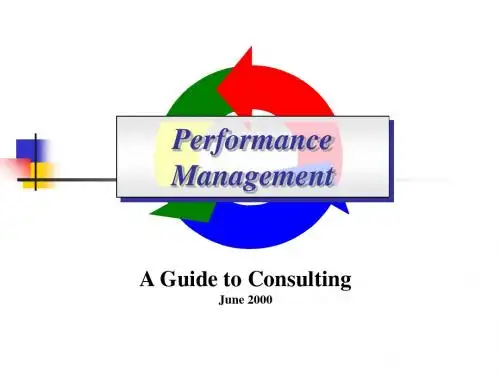
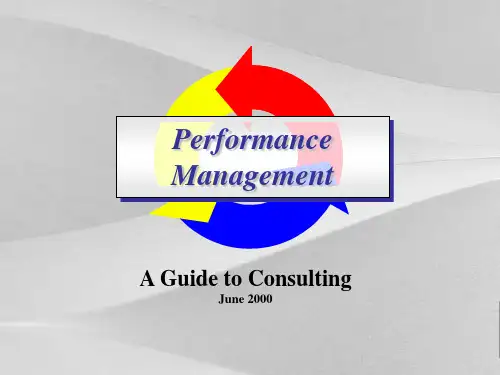
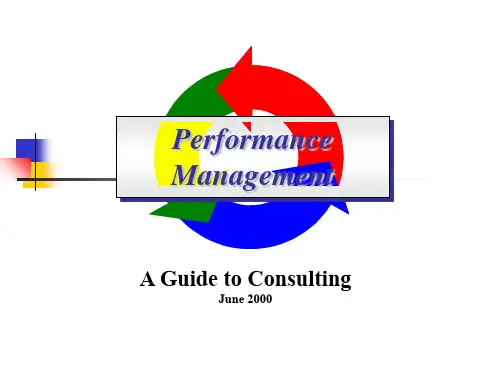
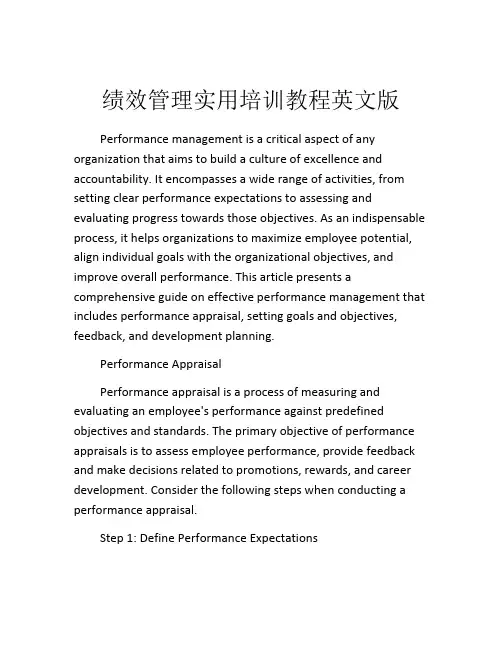
绩效管理实用培训教程英文版Performance management is a critical aspect of any organization that aims to build a culture of excellence and accountability. It encompasses a wide range of activities, from setting clear performance expectations to assessing and evaluating progress towards those objectives. As an indispensable process, it helps organizations to maximize employee potential, align individual goals with the organizational objectives, and improve overall performance. This article presents a comprehensive guide on effective performance management that includes performance appraisal, setting goals and objectives, feedback, and development planning.Performance AppraisalPerformance appraisal is a process of measuring and evaluating an employee's performance against predefined objectives and standards. The primary objective of performance appraisals is to assess employee performance, provide feedback and make decisions related to promotions, rewards, and career development. Consider the following steps when conducting a performance appraisal.Step 1: Define Performance ExpectationsBefore conducting an appraisal, it's essential to establish clear performance expectations. For that, you need to define what constitutes satisfactory performance, identify the behaviors and skills required, and establish specific and measurable performance objectives.Step 2: Monitor PerformanceKeep track of the employee's performance throughout the appraisal cycle. Monitor how progress is being made towards achieving the set objectives and review performance against set standards and expectations.Step 3: Conduct the AppraisalUse a structured and objective approach when conducting the appraisal. Use a performance appraisal form that includes the pre-established performance expectations, areas of strength, weaknesses, and development needs. Be specific about areas that the employee needs to improve.Step 4: Provide Feedback and Plan DevelopmentFeedback is critical in helping employees understand how their performance aligns with organizational objectives. Give clear and constructive feedback on areas where employees excel and areas where they need to improve. Once feedback is provided, plan development activities that will help the employee improve their performance.Setting Goals and ObjectivesSetting clear goals and objectives helps employees to know what is expected of them and what they need to achieve. It also helps to align individual objectives with the organizational strategy and objectives. Consider the following steps when setting goals.Step 1: Set Specific GoalsGoals should be specific, measurable, achievable, relevant, and time-bound (SMART). For example, instead of setting a goal like 'increase sales,' set a SMART goal like 'increase sales by 30% over the next six months.'Step 2: Set Clear ExpectationsClearly state what is expected of the employee in achieving the objectives. Provide guidance and support throughout the goal-setting process.Step 3: Review and Monitor ProgressReview progress regularly and make appropriate changes, if necessary. Monitor performance against established objectives and provide feedback on areas where employees need to focus.FeedbackEffective feedback is essential in performance management. It helps employees to understand their strengths and areas for improvement. It also helps to build a culture of opencommunication within the organization. Consider the following when giving feedback.Step 1: Be ConstructiveFeedback should be constructive and objective. It should focus on areas where the employee excels and areas that need improvement.Step 2: Be TimelyProvide feedback as soon as possible, preferably immediately after the event. This helps to ensure that the feedback is fresh and can be acted upon quickly.Step 3: Be SpecificBe specific when giving feedback. Provide concrete examples that illustrate the employee's behavior and its impact on performance.Development PlanningDevelopment planning helps employees to improve their skills, knowledge, and competencies to achieve their career goals and objectives. It is an essential part of performance management that helps to retain employees and improve overall productivity. Consider the following steps when developing a development plan.Step 1: Identify Development NeedsIdentify areas that need improvement by reviewing performance appraisal results and feedback from supervisors, colleagues, and customers.Step 2: Create a Development PlanCreate a development plan that includes specific goals, timelines, and actions to be taken. Identify appropriate training, mentoring, coaching, or job assignments that will help the employee acquire new skills.Step 3: Implement the PlanImplement the development plan, monitor progress, and make appropriate changes if necessary.ConclusionAn effective performance management system is essential for organizations that aim to build a culture of excellence, accountability, and continuous improvement. It encompasses a wide range of activities, including setting goals and objectives, conducting appraisals, providing feedback, and development planning. By following the steps outlined in this guide, managers can ensure that performance management is an effective tool for achieving individual and organizational goals and objectives.。


Company Performance Management Methods -English VersionIntroductionPerformance management is the process of planning, monitoring, and evaluating employee performance. It is a crucial aspect of managing a company as it helps businesses achieve their goals and objectives, improves employee productivity, and fosters a culture of continuous learning and improvement.This document provides an overview of the various methods used to manage company performance,specifically in the context of English-speaking countries.Key Performance Indicators (KPIs)Key Performance Indicators, or KPIs, are measurable objectives that help companies track progress towards their goals. They enable businesses to monitor the performance of individual employees, teams, and the company as a whole. KPIs can be qualitative or quantitative and may include metrics such as sales revenue, customer satisfaction, employee engagement, and website traffic.To ensure the effectiveness of KPIs, it isessential that they are relevant to the c ompany’s overall strategy, specific to each department’s responsibilities, and clearly communicated toemployees. Regular monitoring and review of KPIs should also be conducted to identify areas of improvement.Performance ApprsalsPerformance apprsals are a formal evaluation of an employee’s performance. They typically assess an employee’s skills, achievements, and areas for improvement. Performance apprsals are an important part of performance management as they help identify trning and development needs, provide feedback to employees, and contribute to decisions around promotions, salary increases, and terminations.An effective performance apprsal process should be fr, objective, and based on measurable criteria. It should also be conducted regularly to ensure that employees receive consistent feedback and have the opportunity to improve their performance.Trning and DevelopmentTrning and development are essential for employees to acquire new skills and knowledge and enhance their performance. Companies can provide a range of trning opportunities, including on-the-job trning, mentorship programs, and formal trning courses.Trning and development programs should be tlored to the specific needs of each employee and aligned with the company’s overall strateg y. They should also be regularly evaluated to ensure that they are effective in improving employee performance.Employee Recognition and RewardsEmployee recognition and rewards are an important part of performance management as they motivate employees to strive for excellence and contribute to the company’s success. They include bonuses, salary increases, promotions, and other incentives.Recognition and rewards should be based on objective criteria and be consistent across all employees. They should also be aligned with the company’s overall strategy and contribute to a culture of continuous improvement.ConclusionPerformance management is an essential aspect of managing a company. By implementing effective methods for managing performance, companies can improve employee productivity, achieve their goals and objectives, and foster a culture of continuous learning and improvement. Key methods of performance management include KPIs, performance apprsals, trning and development, and employee recognition and rewards.。